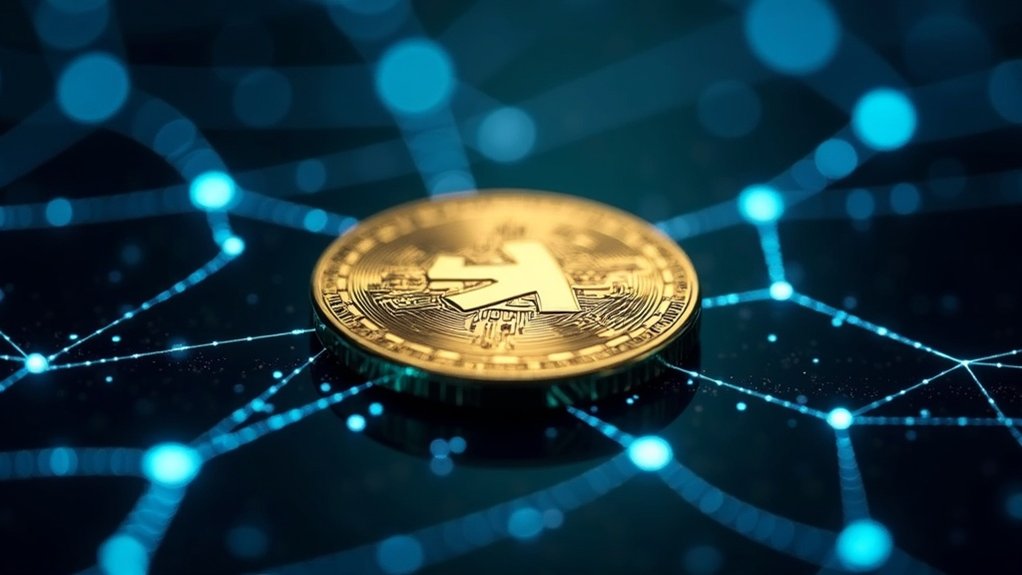BNB originally stood for “Binance Coin” when launched in 2017, but now officially represents “Build and Build,” reflecting Binance’s ambitious vision. It’s the native cryptocurrency of Binance, the world’s largest crypto exchange. Initially an Ethereum-based token, BNB migrated to its own blockchain in 2019. It powers transactions, offers trading fee discounts, and supports smart contracts. Currently a top-5 cryptocurrency by market cap, there’s more to this powerhouse than just its acronym.
Acronyms dominate the crypto world. BNB is one of the biggest players. It stands for Binance Coin, the native cryptocurrency of Binance exchange. Born in 2017, it started life as an ERC-20 token on Ethereum’s blockchain. Humble beginnings at just $0.11 to $0.15 per token during its ICO, which raised about $15 million. Not bad. The name also suggests “Build and Build,” reflecting Binance’s long-term vision. They weren’t kidding about that building part.
BNB didn’t stay an Ethereum token for long. In 2019, it shifted to Binance’s own blockchain, Binance Chain. Smart move. This change gave Binance more control and improved transaction speeds. Later, the BNB Smart Chain (BSC) came along to handle smart contracts and decentralized applications. Evolution at its finest. Like exchange-traded funds, BNB offers investors high liquidity and the ability to trade throughout the day.
Migrating to their own blockchain gave Binance control, speed, and a platform for innovation. Classic crypto evolution.
What’s BNB actually good for? Plenty. Users get discounts on Binance trading fees when paying with BNB. That’s its original purpose. But now it does so much more. It powers transactions across Binance’s blockchain ecosystem, gives access to token sales on Binance Launchpad, and lets holders participate in governance. The network confirms transactions in approximately 3 seconds with very low fees. Utility on steroids.
The Binance ecosystem is complex. Multiple blockchains operate under the BNB umbrella: BNB Beacon Chain for governance, BNB Smart Chain for smart contracts, opBNB and zkBNB for scaling, and BNB Greenfield for storage. The ecosystem includes a coin burning mechanism that regularly reduces the total supply, creating a deflationary effect on BNB.
The Smart Chain has become a popular Ethereum alternative. Cheaper, faster. No wonder developers flocked to it.
In the market, BNB is a heavyweight. Consistently ranked in the top 5 cryptocurrencies by market cap, it’s hit values exceeding $100 billion during bull markets. The price has soared above $600 at times in 2024. Not too shabby for a token that started as a way to get trading fee discounts.
BNB’s success is tied to Binance’s dominance as the world’s largest crypto exchange. Big exchange, big coin. Simple as that.
Frequently Asked Questions
How Does BNB Differ From Bitcoin and Ethereum?
BNB differs from Bitcoin and Ethereum in several key ways.
It’s the native token of Binance’s ecosystem, not just a standalone cryptocurrency.
Uses Proof of Staked Authority consensus, which is faster and cheaper than Bitcoin’s Proof of Work or Ethereum’s Proof of Stake.
Transaction costs? Way lower than Ethereum’s notorious gas fees.
BNB also has quarterly coin burns tied to Binance revenue.
It’s built specifically to power an exchange ecosystem. Bitcoin can’t do smart contracts. Ethereum can, but costs more.
What Determines Bnb’s Market Value?
BNB’s market value rides on multiple factors.
Supply burns create scarcity—less coins, more value. Simple economics.
The token’s utility across Binance’s ecosystem drives demand; people need it for fees, discounts, and DeFi applications.
Market sentiment matters too. When crypto booms, BNB typically follows.
Trading volume, ecosystem expansion, and governance participation all play roles.
And yes, speculation. Traders love to bet on Binance’s next move, sending prices up or down on rumors alone.
Is BNB a Good Long-Term Investment?
BNB presents a mixed investment case.
Strong ecosystem growth and deflationary mechanics work in its favor. Not bad fundamentals.
But risks exist—regulatory concerns hover like storm clouds, and Binance’s centralized control isn’t exactly crypto-purist heaven.
Competition from Ethereum and others? Fierce.
The token’s fate ties directly to Binance’s success, for better or worse.
Long-term viability depends on continued adoption, regulatory navigation, and technological relevance.
Nothing in crypto is certain. Nothing.
How Can I Safely Store My BNB Tokens?
Investors have multiple options for storing BNB tokens securely.
Hardware wallets like Ledger and Trezor offer maximum security, keeping private keys offline and away from hackers.
Software wallets such as Trust Wallet and MetaMask provide convenience with decent protection.
Exchange wallets? Easy but risky. Seriously, don’t keep large amounts there.
Smart storage means backing up seed phrases, enabling two-factor authentication, and never, ever sharing private keys.
Security updates matter too.
What Are the Risks Associated With Investing in BNB?
Investing in BNB comes with significant risks.
Market volatility is extreme—prices swing wildly without warning. Regulatory issues hover constantly; Binance faces scrutiny worldwide.
The token’s value depends heavily on Binance’s ecosystem—if the exchange fails, BNB could collapse. Technical vulnerabilities exist in the BNB Smart Chain.
Centralization concerns are real—fewer validators means higher manipulation risk. Competition from Ethereum and others threatens market share.
And let’s face it: crypto speculation isn’t for the faint-hearted.









